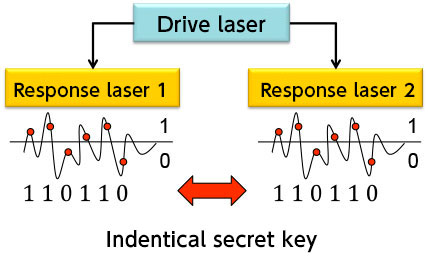Research themes in the Uchida Lab
(2) Information theory security using common signal-induced synchronization
1.Secret key distribution with correlated random sources
In the recent development of our information-oriented society, technologies for assuring data security have become a crucial need. The techniques that are currently commonly used for data encryption deal with security based on computational complexity. In the Uchida Laboratory, we focus on a new aspect of security, namely information theory security, about which we design experimental methods [1]. One example of these methods is to develop information theory security using common signal-induced synchronization of semiconductor lasers [2,3]. Common signal-induced synchronization is a technique in which the signal emitted by a drive laser is injected into two other lasers. These two response lasers can then get synchronized, meaning that their irregular oscillating output signals are in synchrony despite their complexity. By using this phenomenon, security key distribution between two legitimate users can be performed by transmitting them common correlated random signals. This process is called secret key distribution with correlated random sources.
 General scheme for secret key distribution with correlated random sources
General scheme for secret key distribution with correlated random sources
2.Current research topics
We demonstrated experimentally for the first time a successful secret key distribution with correlated random sources between two users separated from each other by 120 km [2]. Moreover, we improved the security quality with a technique using multi-stage semiconductor lasers [3]. For an effective application of secret key distribution with correlated random sources, the output signal of the drive laser in the common signal-induced synchronization process must be protected from potential eavesdroppers. Indeed, if one manages to tap the signal from the drive laser, it becomes then possible to predict the outputs of the legitimate users. In order to prevent this, we are considering using a super luminescent diode with THz-frequency bandwidth as a common-signal noise source. The miniaturization of the experimental part containing the response lasers can prevent undesired effects from air and humidity vibrations and stabilize the synchronization operation. We are working on performing common signal-induced synchronization by implementing the response lasers in photonic integrated circuits.
- References
- [1] J. Muramatsu, et al., Lect. Not. Comp. Sci., Vol. 5973, pp. 128 (2010).
- [2] K. Yoshimura, et al., Physical Review Letters, Vol. 108, pp. 070602 (2012).
- [3] H. Koizumi, et al., Optics Express, Vol. 21, pp. 17869 (2013).
